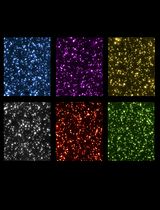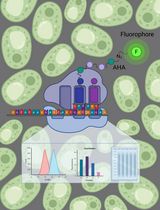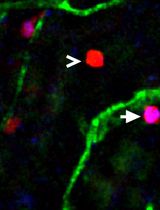- EN - English
- CN - 中文
Fluorescent Labeling of Rat-tail Collagen for 3D Fluorescence Imaging
用于3D荧光成像的鼠尾胶的荧光标记
发布: 2018年07月05日第8卷第13期 DOI: 10.21769/BioProtoc.2919 浏览次数: 9846
评审: Ralph Thomas BoettcherMichela PeregoMasashi Asai
Abstract
Rat tail collagen solutions have been used as polymerizable in vitro three-dimensional (3D) extracellular matrix (ECM) gels for single and collective cell migration assays as well as spheroid formation. These 3D hydrogels are a relatively inexpensive, simple to use model system that can mimic the in vivo physical characteristics of numerous tissues within the body, namely the skin. While confocal imaging techniques such as fluorescence reflection and two-photon microscopy are able to visualize collagen fibrils during 3D imaging without fluorescence, other imaging modalities require direct conjugation of fluorescent dyes to collagen. Here we detail how to generate 3D collagen gels labeled with a fluorescent dye. Furthermore, we go through the steps required to reproducibly generate bright collagen hydrogels that are suitable for live cell 3D imaging techniques.
Keywords: Rat-tail collagen (鼠尾胶)Background
The study of cell migration and cell interaction with its surrounding microenvironment has been started since the 1950’s when Paul Weiss and Beatrice Garber originally observed the effect of increasing plasma concentration (fibrin) on mesenchymal cell morphology (Weiss and Garber, 1952). In subsequent years and decades, biochemists started to delve into purifying extracts from rat tail collagen and started their use as a highly polymerizable 3D matrix (Fitch et al., 1955; Gross et al., 1955; Chandrakasan et al., 1976). It wasn’t until the 1990’s that 3D matrices truly became useful to the cell biology community, especially for studying cell migration (Friedl et al., 1995). Recently, a transition from simplified two-dimensional (2D) studies on ECMs to 3D has begun. This evolution has followed shortly behind the recent advances in fluorescence microscopy, especially super-resolution microscopy. While standard laser scanning confocal microscopes can utilize reflection microscopy or two-photon-based second harmonic generation to visualize collagen fibers in the absence of a fluorescent tag, both techniques do not always properly depict the ECM architecture due either to polarity issues or lack of a significant fibril thickness. A fluorescently-tagged ECM allows imaging of the smallest individual fibrils even with super-resolution techniques.
Unlike most proteins collagen cannot be simply tagged with a fluorophore when in solution because the numerous lysine residues are required for alpha helix formation with other monomers during polymerization (Chandrakasan et al., 1976). For this reason, the labeling must be accomplished on preformed gels. This protocol describes how to label a polymerized gel, bring the collagen back into solution with acetic acid, and properly mix a minimal amount (2-4% of total protein) of labeled collagen with an unlabeled fraction to generate a bright, fluorescent collagen gel capable of sustaining cell viability while allowing observation of ECM architecture over multiple hours of fluorescence imaging.
Materials and Reagents
- MatTek Dishes (35 mm, #1.5 coverslip, 20 mm opening: MATTEK, catalog number: P35G-1.5-20-C )
- ColorpHast pH-indicator-strips with pH range 6.5-10 (Merck, catalog number: 109543 )
- 10-100 and 1,000 μl Gilson MICROMAN® positive displacement pipette tips (Gilson, catalog numbers: FD10004 , FD10006 )
- 10 cm tissue culture dish (Thermo Fisher Scientific, catalog number: 150350 )
- Cell lifters (Corning, catalog number: 3008 )
- Aluminum foil
- Plastic wrap
- Scintillation vial (Sigma-Aldrich, catalog number: Z190527 )
- 1.5 ml microfuge tubes (Thermo Fisher Scientific, catalog number: AM12400 )
- Dubecco’s Minimal Essential Medium (DMEM) powder, Phenol red (Sigma-Aldrich, catalog number: D2429 )
- NaOH pellets (Sigma-Aldrich, catalog number: S8045 )
- Phosphate Buffered Saline with Calcium and Magnesium (PBS++) chilled to 4 °C and at room temperature (GE Healthcare, HycloneTM, catalog number: SH30264.02 )
- Rat tail collagen solution (dissolved in 20 mM acetic acid, commercial brands are fine, but in-house preparations are usually cleaner and polymerize faster) at a concentration greater than 5 mg/ml (6 mg/ml used here)
- Sodium bicarbonate (Sigma-Aldrich, catalog number: S5761 )
- 4-(2-hydroxyethyl)-1-piperazineethanesulfonic acid (HEPES) (Sigma-Aldrich, catalog number: H4034 )
- Boric acid (powder 99.5%, Sigma-Aldrich, catalog number: B6768 )
- Acetic acid (Sigma-Aldrich, catalog number: 27221-1L ) (chilled to 4 °C, less than 50 ml of 16.65 M is required)
- Atto-488 NHS-ester 1 mg (Sigma-Aldrich, catalog number: 41698 )
- DMSO (Sigma-Aldrich, catalog number: D2650 )
- Sircol Collagen Assay kit (available from Accurate Chemical & Scientific, catalog number: CLRS1000 )
- Slide-A-Lyzer Dialysis cassette (G2) with 20,000 MW cutoff (Thermo Fisher Scientific, catalog number: 87735 )
- 1 M Tris (pH 7.4, KD Medical, catalog number: RGF-3340 )
- NaCl (Sigma-Aldrich, catalog number: S7653 )
- HCl (37%, Sigma-Aldrich, catalog number: H1758-500ML )
- 10x DMEM (see Recipes)
- 10x reconstitution buffer (10x RB; see Recipes)
- 1 N NaOH (500 μl in a microfuge tube; see Recipes)
- 1 N HCl (500 μl in a microfuge tube; see Recipes)
- 50 mM Borate buffer pH 9.0 (see Recipes)
- 5 mg/ml Atto-488 NHS-ester dye in DMSO (see Recipes)
- Sodium Chloride (NaCl), 8% solution (see Recipes)
- 50 mM Tris buffer (see Recipes)
Equipment
- 10-100 and 1,000 μl Gilson MICROMAN® positive displacement pipette (Gilson, catalog numbers: F148314 , F148180 )
- Lab timer
- 2-4 L beaker
- Ultra-clear 8 x 20 mm centrifuge tubes (Optional: Beckman Coulter, catalog number: 345843 )
- Rectangular ice bucket packed with ice
- Water bath
- Large Magnetic stir bar to large beaker (Sigma-Aldrich, SP Scienceware - Bel-Art Products - H-B Instrument, catalog number: Z284491 )
- Small Magnetic stir bar for scintillation vial (Sigma-Aldrich, SP Scienceware - Bel-Art Products - H-B Instrument, catalog number: Z126942 )
- Stir plate
- Mini centrifuge (i.e., VWR, model: Galaxy Mini )
- Biological hood (any brand)
- Brightfield microscope with 10 and 20x phase contrast objectives
- Cooled centrifuge capable of 20,000 x g and 4 °C (i.e., TOMY, model: MX-307 )
- Lab Rocker (i.e., Denville Scientific, model: 110, catalog number: S2110 )
- Airfuge ultra centrifuge (optional: Beckman Coulter, catalog number: 340400 )
- Laser scanning or spinning disk confocal microscope (i.e., Nikon Instruments, model: A1R or Yokogawa, model: CSU-X1 )
Procedure
文章信息
版权信息
© 2018 The Authors; exclusive licensee Bio-protocol LLC.
如何引用
Doyle, A. D. (2018). Fluorescent Labeling of Rat-tail Collagen for 3D Fluorescence Imaging. Bio-protocol 8(13): e2919. DOI: 10.21769/BioProtoc.2919.
分类
生物化学 > 蛋白质 > 标记
细胞生物学 > 细胞运动 > 细胞迁移
您对这篇实验方法有问题吗?
在此处发布您的问题,我们将邀请本文作者来回答。同时,我们会将您的问题发布到Bio-protocol Exchange,以便寻求社区成员的帮助。
Share
Bluesky
X
Copy link













